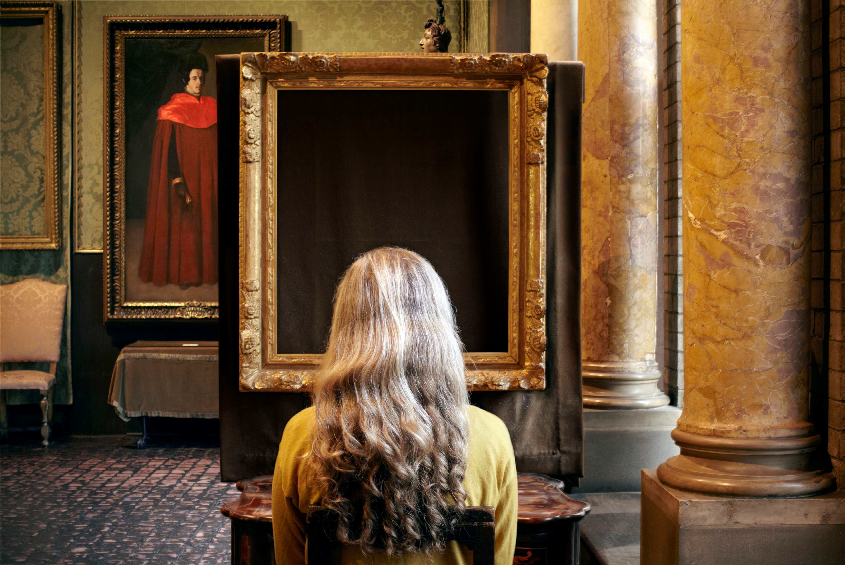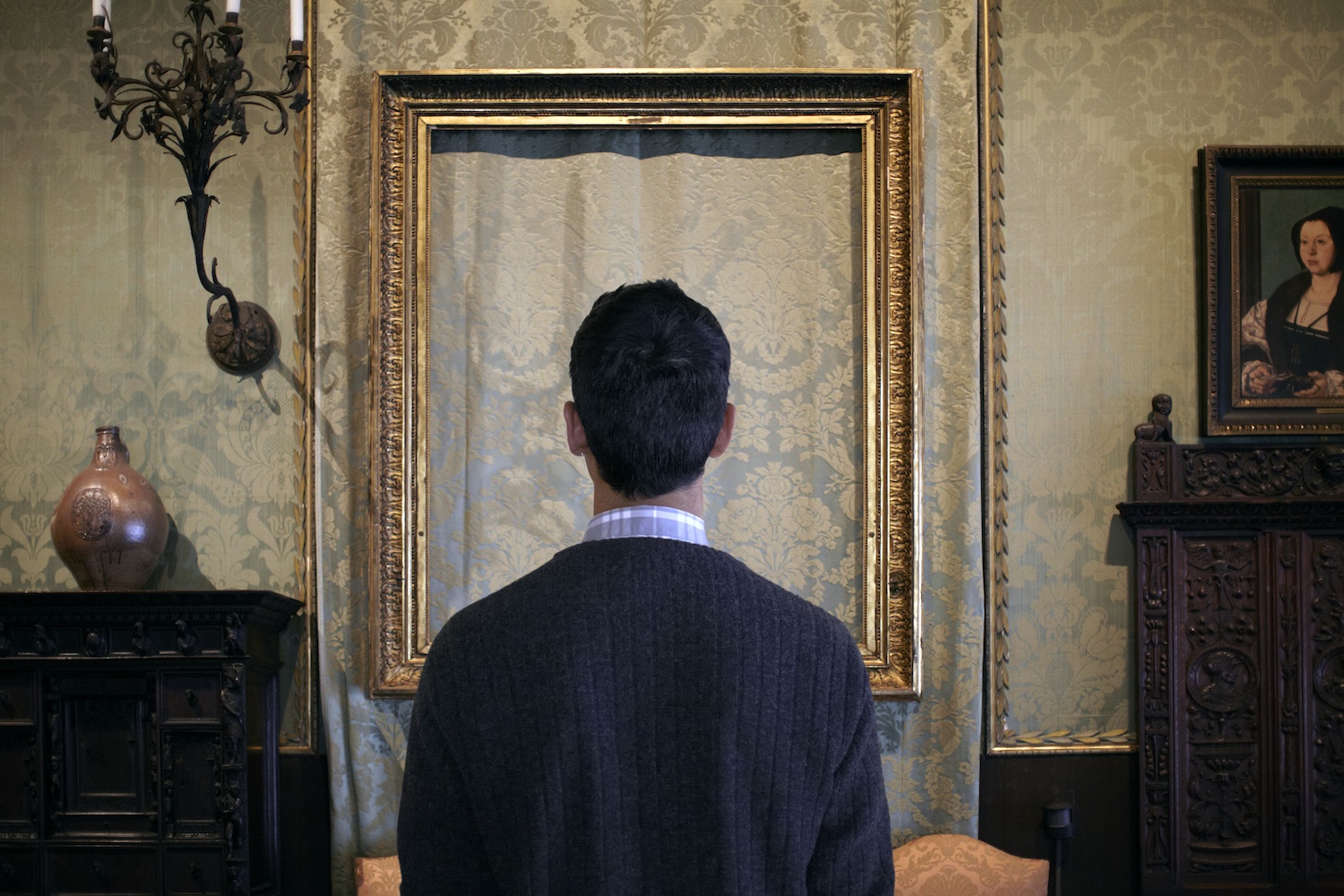
Sophie Calle, What Do You See? (Vermeer, The Concert), 2013 © 2013 Sophie Calle / Artists Rights Society (ARS), New York / ADAGP, Paris. Courtesy of Sophie Calle, Paula Cooper Gallery, New York, and Isabella Stewart Gardner Museum, Boston.
The plague of the white cube as an exhibition space in the contemporary art world is notorious. Many artists spend time trying to avoid the imposed limitations of this neutral venue. White walls offer subtle restrictions, much as the black box constrains theater. Sophie Calle’s latest exhibit at the Isabella Steward Gardener Museum in Boston successfully escapes the monotony of white and displays work mounted on walls soaked in crimson. Last Seen is an invigorated display that embraces vibrancy and eschews minimalism. Not only are the walls painted a deep red (as they were for the companion show, Purloined, at Paula Cooper Gallery last fall), but the floor is a warm blonde wood and her images are opulent. Taken within the lush atmosphere of the Renaissance collection, Calle’s photographs display the gilt frames, floral brocade, richly colored velvet, and heavy tapestries of Gardener’s estate. The rich colors and lavish textures do not make for heavy-handed visuals though; rather, they are subtle observations circling around one of Boston’s greatest mysteries.

Sophie Calle, Last Seen, Installation View
Photo: Stewart Clements Photography
© Sophie Calle / Artists Rights Society (ARS), New York / ADAGP, Paris.
Calle’s work centers on one of the largest art thefts in history, when thirteen masterpieces were robbed from the Gardener collection in 1990, including artworks by Vermeer, Rembrandt, Manet, Degas, and Flinck. For Last Seen Calle interviewed curators, guards, conservators and other staff about the pieces that were taken, but instead of investigating the act of larceny, Calle asks for personal accounts of the missing works. Her interviews gather material to create a portrait of sorts, fractured recollections that form a dark silhouette. Using her characteristic marriage of text and photographs, she places an image of the wall the work once occupied alongside a frame containing threads of the anonymous interviewees’ memories and impressions of a work.

Sophie Calle, What Do You See? (Rembrandt, A Lady and Gentleman in Black), (detail), 2013
1 Lambda print and 1 lithograph on Rives BFK paper
2 panels, each: 26 7/8 x 39 7/8 in. (68.2 x 101.2 cm)
Edition of 2 French, 2 English
© 2013 Sophie Calle / Artists Rights Society (ARS), New York / ADAGP, Paris. Courtesy of Sophie Calle, Paula Cooper Gallery, New York, and Isabella Stewart Gardner Museum, Boston
Prompted by the fact that several of the frames of stolen works were left behind, Calle made a second body of work titled, What Do You See? that continues to probe at the affect of absence. In a notable gesture of stubbornness, Gardener’s will stipulates that the works in her collection may not be rearranged in any way after her death. Thus, in an almost humorous twist, the frames that were left behind must remain in their original place. Again, Calle interviewed staff and visitors (this time without prompting them about the theft) about the framed space on the wall. In the same form of Last Seen, Calle pairs the text she gathers with an image of an onlooker in front of the uninhabited frame, back to the camera, contemplating the wall space. Their gaze hardly lands on empty space- beneath the gold frames are lavish fabrics and grandiose decor. The only thing that feels questionable in the exhibit is Calle’s choice to vary the size of the text between each stolen work of art, but ultimately that is a minor detail because she is a rare breed of artist who can command attention in two realms at once, balancing the visual and written content without one overbearing the other.
Both projects evoke an element of searching, as if in blindness, one feels the face of a new acquaintance, gathering information but lacking a complete sense of the thing. The use of memory to reassemble an understanding of that absence is gentle, a soft pressure of inquiry rather than an interrogation. Calle invites us to engage with the mysterious and the elusive, without inflating it to theatrics or spectacle. She is not writing a novel with dramatization of a crime, rather she is slowly circling the issue, giving us flares of information, subtle details, refracting pieces of the story in our direction. Though she is presenting observations and relying on the contributions of others as she has done often in the past with projects like The Shadow (1981) and Take Care of Yourself (2007), the work still bears her signature. As with much of her practice, she never gives us anything directly. She provides her audience with small tokens, slight compass movements, snatches of information to orient us and bring us closer. In this, her work is patient. It is the denial of sight. As one of her interview subjects notes, “replacement would be dishonest.”

Sophie Calle, Last Seen… (Manet, Chez Tortoni), 1991
1 Ektachrome photograph and 1 lithograph Photo: 53 1⁄2 x 64 9/16 in (136 x 164 cm) Text: 16 1/8 x 19 11/16 in (41 x 50 cm) Edition of 2 French, 2 English
Photo: Dorothy Zeidman
© 2013 Sophie Calle / Artists Rights Society (ARS), New York / ADAGP, Paris. Courtesy of Sophie Calle, Paula Cooper Gallery, New York, and Isabella Stewart Gardner Museum, Boston.
Last Seen and What Do You See? are compact projects, and when left wanting more, it was a delight to meander over to the stone palace to bear witness to the very sites to which Calle devoted so much attention. I took a bit of pleasure in the directly referential nature of seeing a show about the very place I was in, being able to walk into an image just seen, becoming the anonymous spectator lingering in front of a vacant frame. Hunting for the absences that Calle highlights was an invitation to enter the shrine of illusive value. Calle’s work speaks directly to the institution, and more broadly to how art exists in institutions. However, it is far from the griping of institutional critique; rather she gracefully prompts a discourse about the complications of value.
Sophie Calle, Last Seen opened October 24, 2013 and closes March 3, 2014 and is on view in the HOSTETTER GALLERY, Isabella Stewart Gardner Museum, Boston.
This is the first article by contributor Ayden L.M. Grout on ETTD. For her full bio please visit the contributors section.
More soon!
xo
